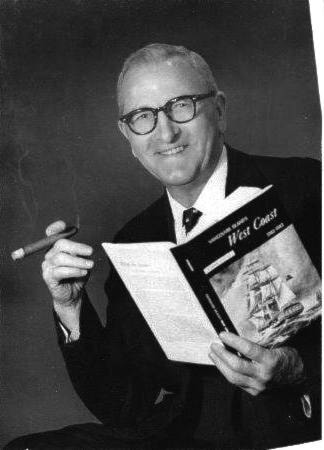Elida Peers | Contributed
A west coast raconteur that I enjoyed meeting was Major George Nicholson, shown with the book he self-published in 1962, which became a significant resource for all early Vancouver Island history researchers.
It was a real treat for Sooke when he and his pal, Gerry Andrews, B.C.’s Surveyor-General, came to entertain us in Sooke Community Hall in the 1970s.
Born with a spirit of adventure in Wellington, New Zealand, in 1887, George Nicholson, one of five boys in a family of 15 siblings, found work in both Fiji and Australia while still in his teens. He married young and settled first in New Zealand with his bride Mary Wilson and started a family, but by 1910 adventure had called again, and he had arrived in Victoria.
He quickly found work as secretary at the Camosun Club, “a drinking club for what was known then as the city’s male upper crust.” He sent for his wife and kids to join him, but again, it wasn’t for long, as he went overseas to serve in the First World War, reached the rank of major, wounded and awarded the Military Cross.
Returning to Victoria, his job was gone, but by 1919 he was manager of the Sooke Harbour Hotel, which stood on the headland above the Sooke River’s mouth.
We had heard a lot about the four-storey hotel, which burned down in 1934, but it wasn’t until I met with his grandchildren, Joan Nicholson Payne and Colin Nicholson, recently learned about the beer the major produced in the basement.
The hotel earned a reputation as a centre for exciting activities, so it was no wonder that the Prince of Wales (later Duke of Windsor) made a stop in Sooke on his 1919 Canadian tour.
For the Victoria visit, Major Nicholson served as aide-de-camp to the prince, accompanying him to various rendezvous. We had already heard that East Sooke’s Lady Emily Walker was a guest at the Empress Hotel dance that feted the prince, and we have now learned that the major’s wife Mary danced with the prince as well.
The major long ago recounted to his grandchildren that when he was escorting the prince’s entourage to embark for Vancouver and admired the prince’s hat, the prince promptly removed it and gave it to the major.
Prohibition in the U.S. was in effect from 1920 to 1933; consequently, the nighttime waters of the Strait of Juan de Fuca were soon thronged with vessels engaged in bootlegging, and the major was not about to be left behind.
He recounted borrowing $1,000 to buy his first load of liquor, and when he was back in Sooke the next morning after his first run, he had $3,000 in his pocket.
After four lucrative years at the Sooke Harbour Hotel, he took his family to Port Renfrew, where he managed the hotel on the inlet. He called it an even better base for bootlegging until the Bible student group moved from Sooke to Renfrew in the 1920s made him leave town.
Next, he managed the Clayoquot Lodge before moving to Tofino, where he ran that hotel for five years. He said there was not much business, but perhaps the village’s doctor used it most. As there was no hospital, the doctor would use the hotel’s dining room table for operations. If an appendectomy were needed, the instruments would be sterilized in the pot that had recently cooked the morning’s porridge.
The major’s next stop was Zeballos, which had a population of about 100, living primarily in tents and makeshift accommodations, with the lure of gold attracting more all the time.
He soon became the general factotum, serving as postmaster, marriage commissioner, justice of the peace, harbourmaster, deputy mining recorder, agent for Standard Oil and the Department of Veterans Affairs, and more.
He said that all the gold was shipped out on the Princess Maquinna. Between the vessel’s pickups, the gold bricks had to be stored; the safe in the post office was inadequate, so Nicholson found himself hiding hundreds of thousands of dollars’ worth of gold bricks under beds in his own home.
By this time, the Nicholson daughters, Gretel and Bonnie, were grown and on their own, and son Cecil made his home in Zeballos. Mary Nicholson was a kindly woman who supported her husband in all his endeavours and was often called the “Mother of Zeballos.” Among her many activities, in 1938, she was fund-raising for a hospital. Returning from a fund-raising trip to Vancouver, on Ginger Coote Airways, she was among the four lost when the Fairchild, immersed in fog, hit a remote mountain. It was a year later before searchers found the wreckage.
When the Second World War began, the major served briefly as well, with the Canadian Scottish.
He remarried and lived in Tofino and in Victoria, where he made his home on Vancouver Street when I interviewed him. Again widowed, he had set his sights on publishing a book that would share his vast knowledge of Vancouver Island’s pioneer days. Published in 1962, it became a Canadian bestseller.
Gretel and Bonnie Arnet each married brothers, sons of the Norwegian fishing family of Arnets in Tofino. During the days of the “gumboot navy” in the 1940s, Bonnie and Bjarne Arnet lived in Sooke, raising their daughter Beverly and son Edgar, who attended Sooke School their mother had done years earlier.
Gretel and Trygve Arnet made their home in Victoria and raised a daughter, Lorraine.
Cecil Nicholson and his wife Margaret Hansen raised two children, Joan and Colin. Widowed, Cecil married Fran Holmes, and they raised a daughter Kim.
Still chuckling when he recounted his memoirs for friends, George Nicholson died in 1980 at age 92.
•••
Elida Peers is the historian of the Sooke Region Museum.
editor@sookenewsmirror.com
Like us on Facebook and follow us on Twitter
